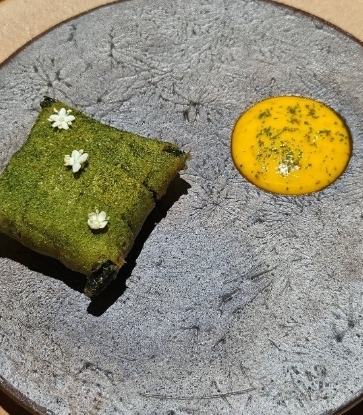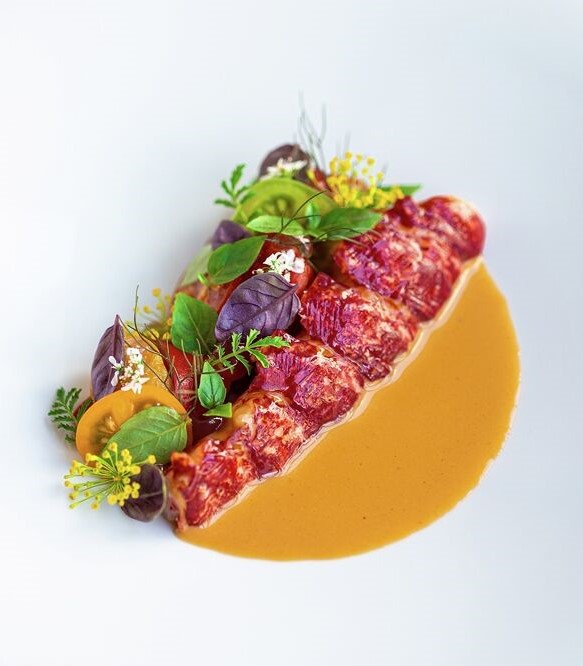Yoshihiro Murata of Kikunoi Honten won the Mentor Chef Award in the MICHELIN Guide Kyoto Osaka 2024.
The Mentor Chef Award is awarded to chefs whose work and career serve as a role model for others. The award honours chefs who devote themselves to training the next generation, serve with passion as guides for others, or contribute to the advancement of the restaurant industry.
Kikunoi Honten, reached by crossing through Maruyama Park from Yasaka Shrine, accompanies Kyoto residents through all the stages of their lives.
A young child, held in his grandmother’s arms after a shrine visit, enters through this restaurant’s traditional noren banner for the first time. He will come again for the Shichi-Go-San (7-5-3) celebration, then for Coming-of-Age Day festivities, the first meeting between his and his fiancée’s parents, his formal wedding engagement, family members’ traditional 77th and 88th birthday celebrations of long life, and even their memorial services.
The third owner-chef, Yoshihiro Murata, believes that a restaurant’s fundamental purpose is to accompany guests through these key moments of their lives.
He begins by saying, ‘The way the next generation is raised and developed depends on older chefs around my age. So it’s crucial that we convey not just how to prepare dishes but how to think about and understand food.’
Bringing Washoku to the World
Some 50 years ago, Murata was training in Paris. Japanese food largely went unrecognised at the time, seen as just carbohydrates like sushi or noodles and lacking nutrition.
Raised in a Japanese restaurant family, Murata was surprised and disheartened to discover that the cuisine his father and grandfather treated so seriously was dismissed so carelessly.
That was the moment when Murata vowed to devote his life and career to sharing accurate knowledge of Japanese cuisine with the world.
Later in his career, he launched a Japanese cuisine academy in 2004 with students and chefs who shared that same sense of mission. First, they set out to provide accurate information about Japanese cuisine by quantifying preparation methods that were typically reliant on experience and instinct.
In French cuisine, chefs speak precisely with points like ‘What is the core temperature?’ ‘How many minutes does it cook?’ ‘How many minutes does the sauce take to separate?’ Murata felt that he had to speak about Japanese cuisine in that same language in order to put it on the same level.
He began writing down things he had learned while practicing his craft, such as how fish salted in advance and fish salted on the spot should be cooked differently.
In addition, Murata’s wide-ranging activities, such as Washoku events with chefs invited from around the globe and dietary educations at schools, have borne fruit, with Washoku being registered as a UNESCO Intangible World Heritage in 2013.

Continuity and change
A youth watched over by his predecessors
Murata was called the maverick or whizz-kid of Kyo-ryori, traditional Kyoto cuisine, in his youth. How was he able to press ahead in a world with such deep veneration for tradition?Murata notes that while some said this genre of cuisine could not be changed, Eiichi Takahashi, from the renowned Hyotei restaurant in Kyoto, encouraged him and told him ‘do as you like’. The previous chef at Miyamaso, Yoshitsugu Nakahigashi, also looked out for him, and taught him.
Murata recalled a memory from his youth. He had simmered foie gras and layered steamed daikon radish with it like a mille-feuille. Then he laid slices of kumquat on top and made the dish look like a ball.
But when a confident Murata brought it out to Takahashi, the response was straight to the point.
‘Murata, how are we supposed to eat this? You don’t need to do anything strange: it’s enough to use the daikon and monkfish liver, then put the kumquat on top. Even if it doesn’t look particularly eye-catching, what’s the difference as long as it’s delicious?’
From this, Murata learned the importance of displaying creativity while staying within the framework of Kyo-ryori.
Murata laughed at his success of having achieved something that an 80-year-old grandmother might kindly respond to with, ‘I hadn’t known about it, but I guess there’s this kind of Kyo-ryori, too’.
A good example might be his yokan sweets, which look unremarkable at first glance, but taste completely different from what you would imagine. With brandy-soaked raisins or lemon peel mixed in, the Western elements harmonise beautifully with the anko bean paste.
Murata comments, ‘Perhaps I should call these “nouvelle yokan”? If I do, even elderly Kyoto matrons will willingly try one, say it’s “different than expected, but good somehow,” and enjoy it.’

Finally, Murata closed this interview with two messages for young chefs.
Don’t prepare dishes for yourself
Murata emphasises that a restaurant shouldn’t be run as a place for self-satisfaction or self-expression.He describes how in the old days, when he brought out rose-coloured duck loin, meat served rare wasn’t yet mainstream, so the guest asked that it be cooked more. So, he would cook it a bit more, and the guests would happily say, ‘this is just right’. It made sense that they would find the dish delicious when prepared this way.
Now, to Murata, this wasn’t the best possible way to prepare this dish. But to work as a chef, you must maintain the mindset of making what your guests will most enjoy.
Restaurants don’t choose guests. Guests choose restaurants. Being a chef means creating food that brings happiness to the people who eat it.
Don’t overdo it; don’t take shortcuts
Working as a chef is a marathon. Sprint the first 100 metres, and you won’t make it through the remaining 42 kilometres.While you’re just setting off, it’s important to diligently do whatever you can. You won’t necessarily get to do creative work straight away. Keep washing the same pots every day.
Gradually layer thin sheets of paper together over time, and eventually your efforts will deliver results—as though taking on a three-dimensional shape.
You must also believe strongly in your work and never give up.
Why do you want to be a chef? Who do you want to make food for? If you keep asking questions and continue working hard, the right path is sure to open up before you.




















